Menu Engineering for Restaurant Success
VerifiedAdded on 2020/11/23
|13
|3715
|287
Report
AI Summary
This assignment delves into the principles of menu engineering in the context of successful restaurant management. It examines how menu design influences customer choices, profitability, and overall business strategy. The report highlights the importance of balancing high and low-cost menu items, strategically positioning dishes, and incorporating nutritional considerations. Additionally, it discusses the role of menus in conveying a restaurant's philosophy and brand identity.
Contribute Materials
Your contribution can guide someone’s learning journey. Share your
documents today.

HOSPITALITY
OPERATIONS
OPERATIONS
Secure Best Marks with AI Grader
Need help grading? Try our AI Grader for instant feedback on your assignments.
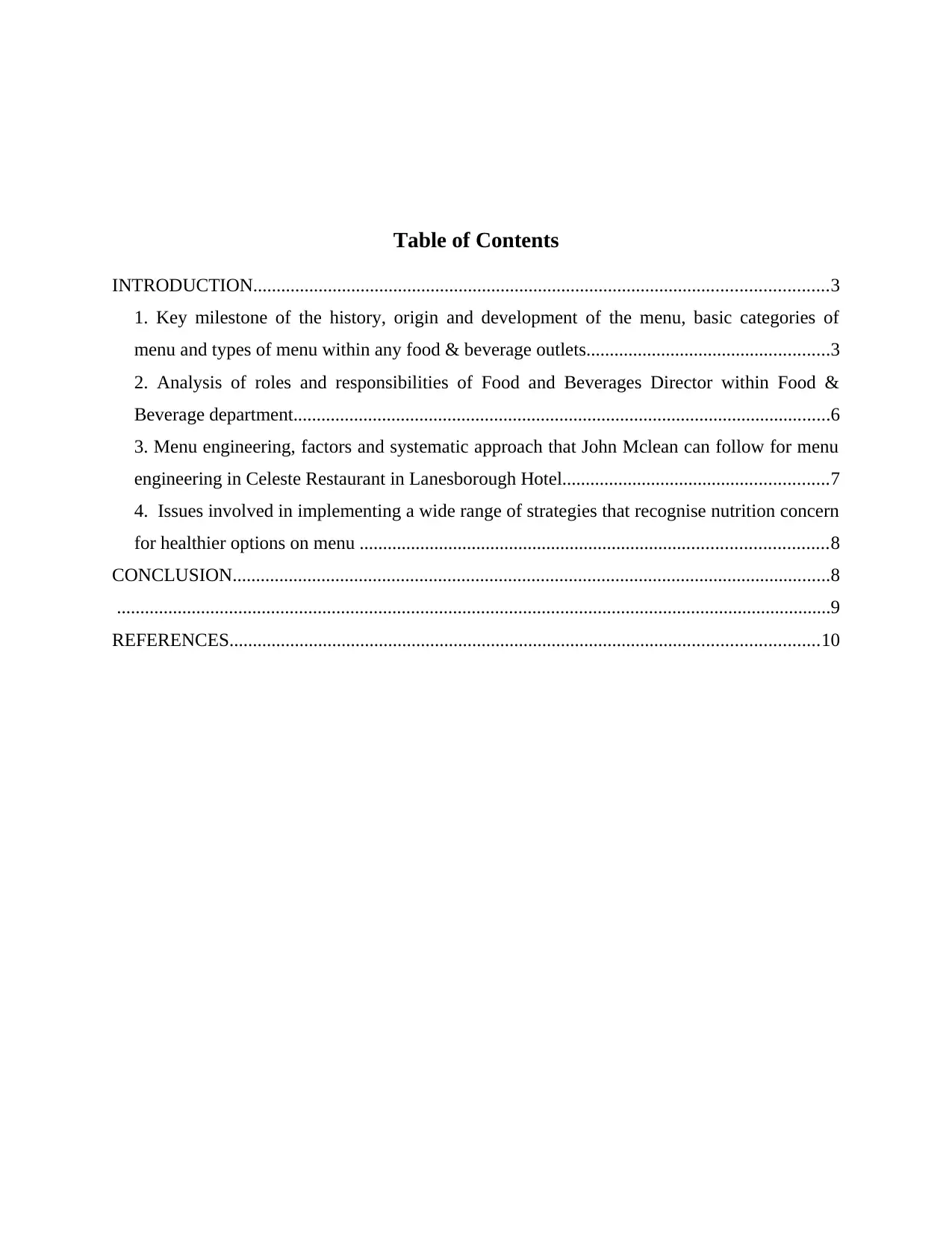
Table of Contents
INTRODUCTION...........................................................................................................................3
1. Key milestone of the history, origin and development of the menu, basic categories of
menu and types of menu within any food & beverage outlets....................................................3
2. Analysis of roles and responsibilities of Food and Beverages Director within Food &
Beverage department...................................................................................................................6
3. Menu engineering, factors and systematic approach that John Mclean can follow for menu
engineering in Celeste Restaurant in Lanesborough Hotel.........................................................7
4. Issues involved in implementing a wide range of strategies that recognise nutrition concern
for healthier options on menu ....................................................................................................8
CONCLUSION................................................................................................................................8
.........................................................................................................................................................9
REFERENCES..............................................................................................................................10
INTRODUCTION...........................................................................................................................3
1. Key milestone of the history, origin and development of the menu, basic categories of
menu and types of menu within any food & beverage outlets....................................................3
2. Analysis of roles and responsibilities of Food and Beverages Director within Food &
Beverage department...................................................................................................................6
3. Menu engineering, factors and systematic approach that John Mclean can follow for menu
engineering in Celeste Restaurant in Lanesborough Hotel.........................................................7
4. Issues involved in implementing a wide range of strategies that recognise nutrition concern
for healthier options on menu ....................................................................................................8
CONCLUSION................................................................................................................................8
.........................................................................................................................................................9
REFERENCES..............................................................................................................................10
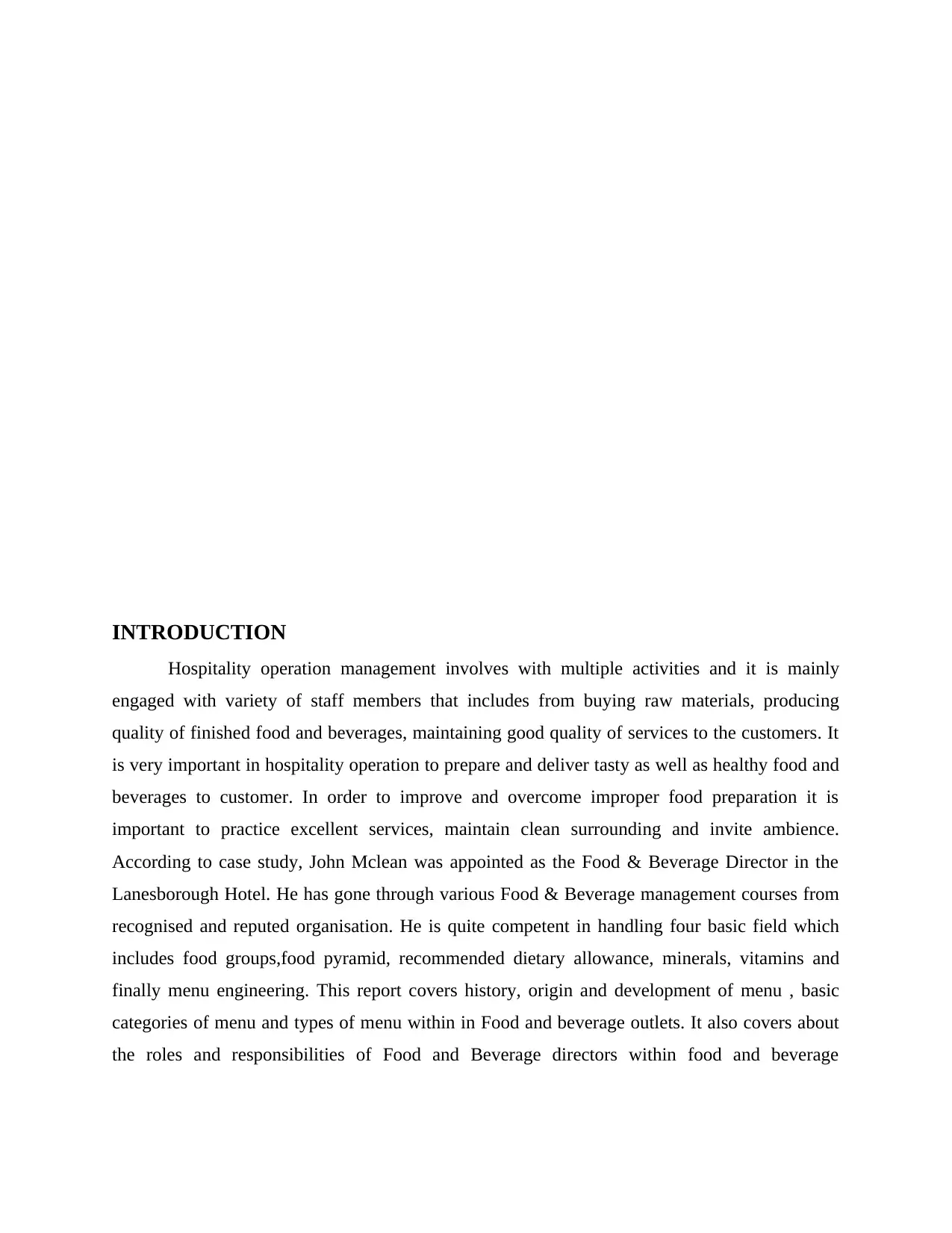
INTRODUCTION
Hospitality operation management involves with multiple activities and it is mainly
engaged with variety of staff members that includes from buying raw materials, producing
quality of finished food and beverages, maintaining good quality of services to the customers. It
is very important in hospitality operation to prepare and deliver tasty as well as healthy food and
beverages to customer. In order to improve and overcome improper food preparation it is
important to practice excellent services, maintain clean surrounding and invite ambience.
According to case study, John Mclean was appointed as the Food & Beverage Director in the
Lanesborough Hotel. He has gone through various Food & Beverage management courses from
recognised and reputed organisation. He is quite competent in handling four basic field which
includes food groups,food pyramid, recommended dietary allowance, minerals, vitamins and
finally menu engineering. This report covers history, origin and development of menu , basic
categories of menu and types of menu within in Food and beverage outlets. It also covers about
the roles and responsibilities of Food and Beverage directors within food and beverage
Hospitality operation management involves with multiple activities and it is mainly
engaged with variety of staff members that includes from buying raw materials, producing
quality of finished food and beverages, maintaining good quality of services to the customers. It
is very important in hospitality operation to prepare and deliver tasty as well as healthy food and
beverages to customer. In order to improve and overcome improper food preparation it is
important to practice excellent services, maintain clean surrounding and invite ambience.
According to case study, John Mclean was appointed as the Food & Beverage Director in the
Lanesborough Hotel. He has gone through various Food & Beverage management courses from
recognised and reputed organisation. He is quite competent in handling four basic field which
includes food groups,food pyramid, recommended dietary allowance, minerals, vitamins and
finally menu engineering. This report covers history, origin and development of menu , basic
categories of menu and types of menu within in Food and beverage outlets. It also covers about
the roles and responsibilities of Food and Beverage directors within food and beverage

department. This report focus on menu engineering and analysis of factors along with the
implementation of wide range of strategies that recognise nutrition concerns.
1. Key milestone of the history, origin and development of the menu, basic categories of menu
and types of menu within any food & beverage outlets.
In hotel and restaurant, menu is considered as a list of food and beverages that is offered
to customers for place their orders. Through menu guests are able to choose their taste food item
and beverages from a list of options.
HISTORY OF MENU
In context with the history, origin and development of menu, it is termed as list of
prepared food that was discovered dating back to the song dynasty in China. Due to large
population, the merchants and dealer found an effective way to cater to the customers that had
very limited time and energy to prepare food items in evening. The word “menu”is French origin
that is usually use for the terminology of cuisine. Menu is ultimately derives from the Latin
“minutus” which means something made small. Earlier the original menu was offered as
consumers choice that were mainly prepared on small chalkboard. The menu as firstly
formulated and implemented in China during the second half of the eighteenth century or the era
of romantic age. Earlier, dishes was chosen and prepared by chef or proprietors before the arrival
and establishment of menu. Customer use to ate only those food items that was severed for that
particular day. With the arrival and establishment of menu at restaurant and hotels customers are
able to choose and select food items or beverages from a list of unseen dishes. The dishes were
produced and prepared on the basis of order placed by the customers. Moreover, the arrival of
menu allows customers to spend money according to their affordable prices or as little money
they want to spend on their food consumption (Wright and Ransom, 2005).
In context to economics of menu production, in mid of 20th century there were many
restaurants that relied on different menu specialists in order to design and print menus for
implementation in food and beverages businesses. Before the introduction of digital printing
there were niche printing companies that use to print coloured menus on offset presses. It terms
of economics the practice of printing coloured menus becomes very impractical and expensive
after short time duration. Later menu shell was developed in order to overcome this issue. During
economics crisis there were many restaurants and hotels that where facing issues with the incur
costs to reprint the menu as the inflation causes increase in the prices. In order to modify menu
implementation of wide range of strategies that recognise nutrition concerns.
1. Key milestone of the history, origin and development of the menu, basic categories of menu
and types of menu within any food & beverage outlets.
In hotel and restaurant, menu is considered as a list of food and beverages that is offered
to customers for place their orders. Through menu guests are able to choose their taste food item
and beverages from a list of options.
HISTORY OF MENU
In context with the history, origin and development of menu, it is termed as list of
prepared food that was discovered dating back to the song dynasty in China. Due to large
population, the merchants and dealer found an effective way to cater to the customers that had
very limited time and energy to prepare food items in evening. The word “menu”is French origin
that is usually use for the terminology of cuisine. Menu is ultimately derives from the Latin
“minutus” which means something made small. Earlier the original menu was offered as
consumers choice that were mainly prepared on small chalkboard. The menu as firstly
formulated and implemented in China during the second half of the eighteenth century or the era
of romantic age. Earlier, dishes was chosen and prepared by chef or proprietors before the arrival
and establishment of menu. Customer use to ate only those food items that was severed for that
particular day. With the arrival and establishment of menu at restaurant and hotels customers are
able to choose and select food items or beverages from a list of unseen dishes. The dishes were
produced and prepared on the basis of order placed by the customers. Moreover, the arrival of
menu allows customers to spend money according to their affordable prices or as little money
they want to spend on their food consumption (Wright and Ransom, 2005).
In context to economics of menu production, in mid of 20th century there were many
restaurants that relied on different menu specialists in order to design and print menus for
implementation in food and beverages businesses. Before the introduction of digital printing
there were niche printing companies that use to print coloured menus on offset presses. It terms
of economics the practice of printing coloured menus becomes very impractical and expensive
after short time duration. Later menu shell was developed in order to overcome this issue. During
economics crisis there were many restaurants and hotels that where facing issues with the incur
costs to reprint the menu as the inflation causes increase in the prices. In order to modify menu
Secure Best Marks with AI Grader
Need help grading? Try our AI Grader for instant feedback on your assignments.
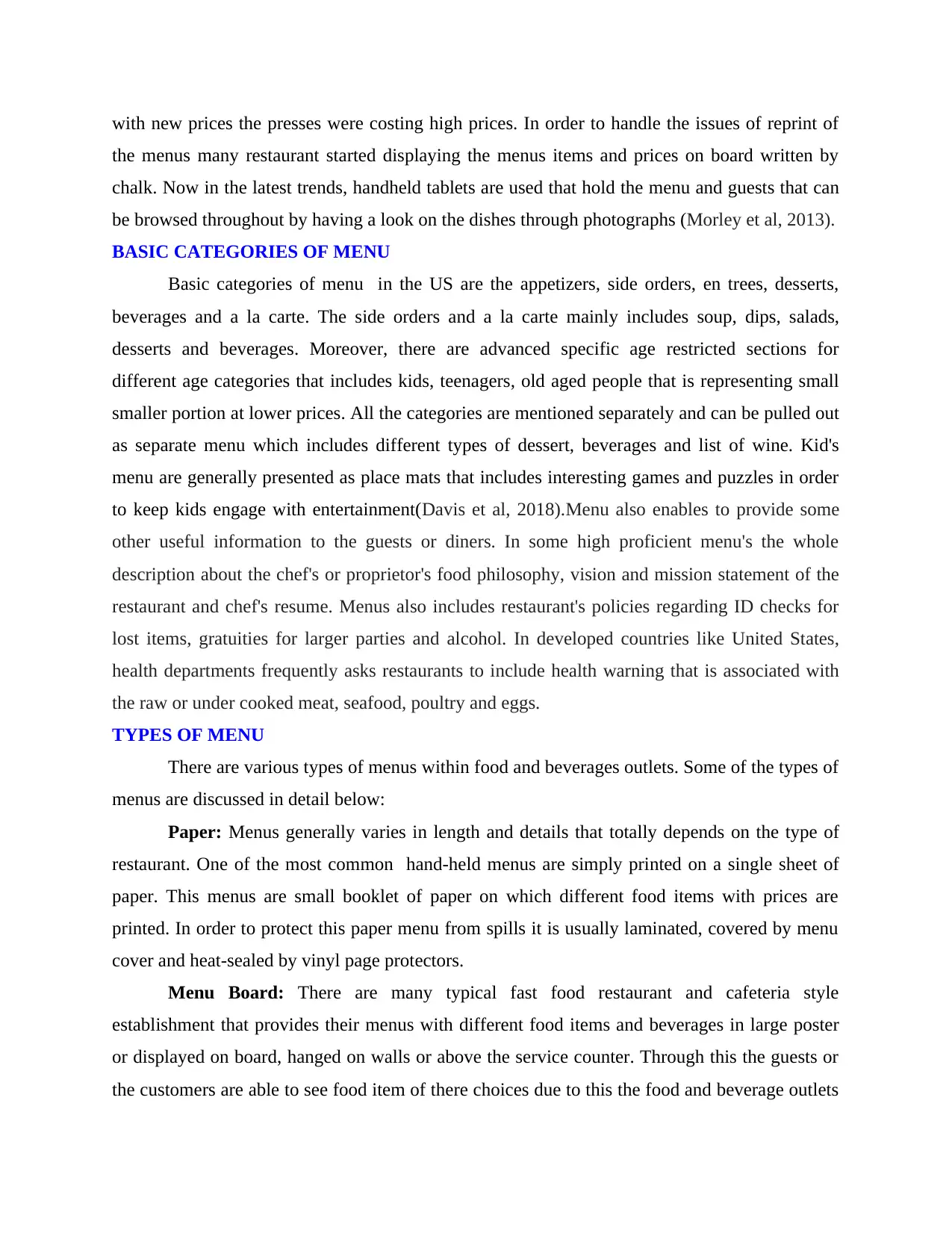
with new prices the presses were costing high prices. In order to handle the issues of reprint of
the menus many restaurant started displaying the menus items and prices on board written by
chalk. Now in the latest trends, handheld tablets are used that hold the menu and guests that can
be browsed throughout by having a look on the dishes through photographs (Morley et al, 2013).
BASIC CATEGORIES OF MENU
Basic categories of menu in the US are the appetizers, side orders, en trees, desserts,
beverages and a la carte. The side orders and a la carte mainly includes soup, dips, salads,
desserts and beverages. Moreover, there are advanced specific age restricted sections for
different age categories that includes kids, teenagers, old aged people that is representing small
smaller portion at lower prices. All the categories are mentioned separately and can be pulled out
as separate menu which includes different types of dessert, beverages and list of wine. Kid's
menu are generally presented as place mats that includes interesting games and puzzles in order
to keep kids engage with entertainment(Davis et al, 2018).Menu also enables to provide some
other useful information to the guests or diners. In some high proficient menu's the whole
description about the chef's or proprietor's food philosophy, vision and mission statement of the
restaurant and chef's resume. Menus also includes restaurant's policies regarding ID checks for
lost items, gratuities for larger parties and alcohol. In developed countries like United States,
health departments frequently asks restaurants to include health warning that is associated with
the raw or under cooked meat, seafood, poultry and eggs.
TYPES OF MENU
There are various types of menus within food and beverages outlets. Some of the types of
menus are discussed in detail below:
Paper: Menus generally varies in length and details that totally depends on the type of
restaurant. One of the most common hand-held menus are simply printed on a single sheet of
paper. This menus are small booklet of paper on which different food items with prices are
printed. In order to protect this paper menu from spills it is usually laminated, covered by menu
cover and heat-sealed by vinyl page protectors.
Menu Board: There are many typical fast food restaurant and cafeteria style
establishment that provides their menus with different food items and beverages in large poster
or displayed on board, hanged on walls or above the service counter. Through this the guests or
the customers are able to see food item of there choices due to this the food and beverage outlets
the menus many restaurant started displaying the menus items and prices on board written by
chalk. Now in the latest trends, handheld tablets are used that hold the menu and guests that can
be browsed throughout by having a look on the dishes through photographs (Morley et al, 2013).
BASIC CATEGORIES OF MENU
Basic categories of menu in the US are the appetizers, side orders, en trees, desserts,
beverages and a la carte. The side orders and a la carte mainly includes soup, dips, salads,
desserts and beverages. Moreover, there are advanced specific age restricted sections for
different age categories that includes kids, teenagers, old aged people that is representing small
smaller portion at lower prices. All the categories are mentioned separately and can be pulled out
as separate menu which includes different types of dessert, beverages and list of wine. Kid's
menu are generally presented as place mats that includes interesting games and puzzles in order
to keep kids engage with entertainment(Davis et al, 2018).Menu also enables to provide some
other useful information to the guests or diners. In some high proficient menu's the whole
description about the chef's or proprietor's food philosophy, vision and mission statement of the
restaurant and chef's resume. Menus also includes restaurant's policies regarding ID checks for
lost items, gratuities for larger parties and alcohol. In developed countries like United States,
health departments frequently asks restaurants to include health warning that is associated with
the raw or under cooked meat, seafood, poultry and eggs.
TYPES OF MENU
There are various types of menus within food and beverages outlets. Some of the types of
menus are discussed in detail below:
Paper: Menus generally varies in length and details that totally depends on the type of
restaurant. One of the most common hand-held menus are simply printed on a single sheet of
paper. This menus are small booklet of paper on which different food items with prices are
printed. In order to protect this paper menu from spills it is usually laminated, covered by menu
cover and heat-sealed by vinyl page protectors.
Menu Board: There are many typical fast food restaurant and cafeteria style
establishment that provides their menus with different food items and beverages in large poster
or displayed on board, hanged on walls or above the service counter. Through this the guests or
the customers are able to see food item of there choices due to this the food and beverage outlets
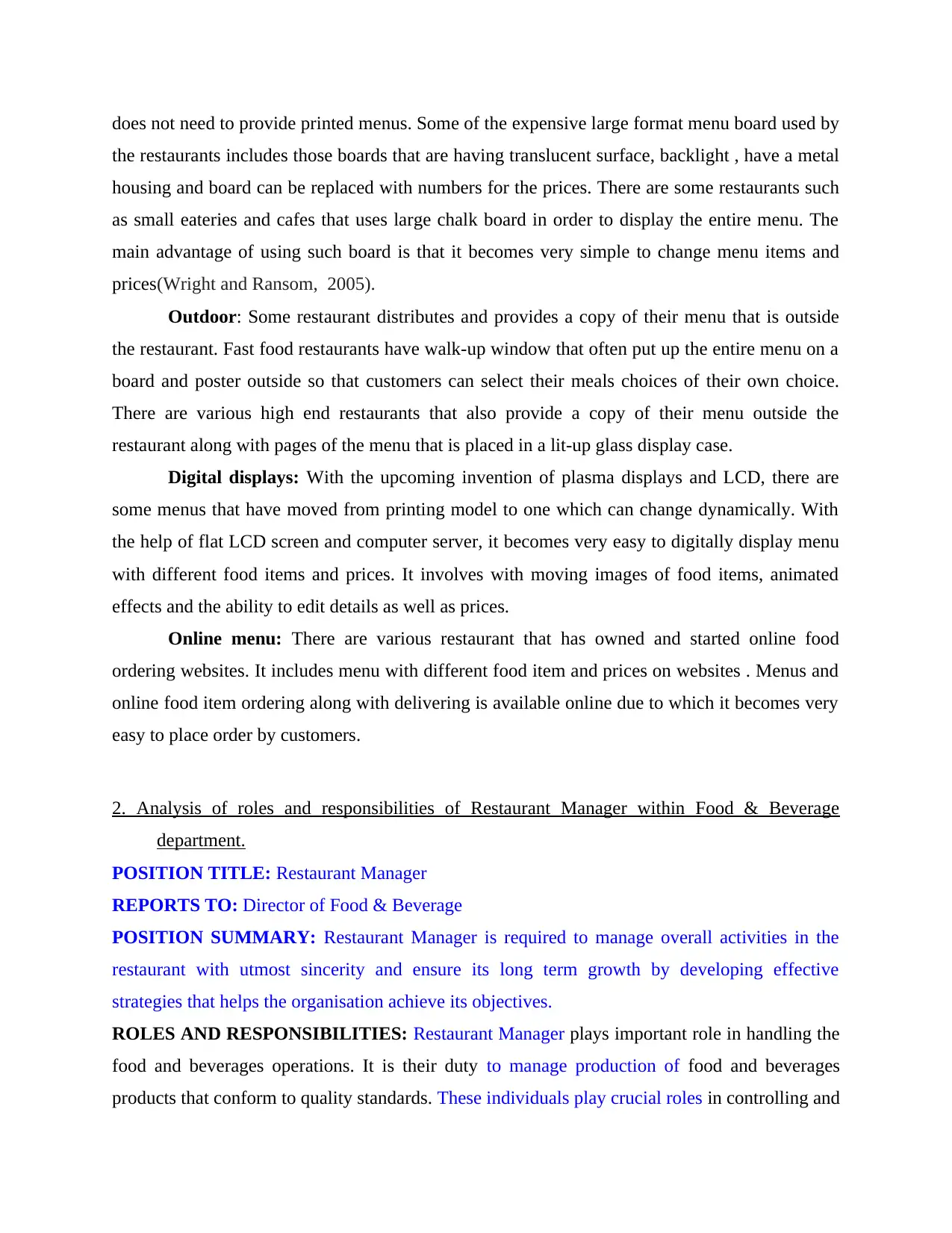
does not need to provide printed menus. Some of the expensive large format menu board used by
the restaurants includes those boards that are having translucent surface, backlight , have a metal
housing and board can be replaced with numbers for the prices. There are some restaurants such
as small eateries and cafes that uses large chalk board in order to display the entire menu. The
main advantage of using such board is that it becomes very simple to change menu items and
prices(Wright and Ransom, 2005).
Outdoor: Some restaurant distributes and provides a copy of their menu that is outside
the restaurant. Fast food restaurants have walk-up window that often put up the entire menu on a
board and poster outside so that customers can select their meals choices of their own choice.
There are various high end restaurants that also provide a copy of their menu outside the
restaurant along with pages of the menu that is placed in a lit-up glass display case.
Digital displays: With the upcoming invention of plasma displays and LCD, there are
some menus that have moved from printing model to one which can change dynamically. With
the help of flat LCD screen and computer server, it becomes very easy to digitally display menu
with different food items and prices. It involves with moving images of food items, animated
effects and the ability to edit details as well as prices.
Online menu: There are various restaurant that has owned and started online food
ordering websites. It includes menu with different food item and prices on websites . Menus and
online food item ordering along with delivering is available online due to which it becomes very
easy to place order by customers.
2. Analysis of roles and responsibilities of Restaurant Manager within Food & Beverage
department.
POSITION TITLE: Restaurant Manager
REPORTS TO: Director of Food & Beverage
POSITION SUMMARY: Restaurant Manager is required to manage overall activities in the
restaurant with utmost sincerity and ensure its long term growth by developing effective
strategies that helps the organisation achieve its objectives.
ROLES AND RESPONSIBILITIES: Restaurant Manager plays important role in handling the
food and beverages operations. It is their duty to manage production of food and beverages
products that conform to quality standards. These individuals play crucial roles in controlling and
the restaurants includes those boards that are having translucent surface, backlight , have a metal
housing and board can be replaced with numbers for the prices. There are some restaurants such
as small eateries and cafes that uses large chalk board in order to display the entire menu. The
main advantage of using such board is that it becomes very simple to change menu items and
prices(Wright and Ransom, 2005).
Outdoor: Some restaurant distributes and provides a copy of their menu that is outside
the restaurant. Fast food restaurants have walk-up window that often put up the entire menu on a
board and poster outside so that customers can select their meals choices of their own choice.
There are various high end restaurants that also provide a copy of their menu outside the
restaurant along with pages of the menu that is placed in a lit-up glass display case.
Digital displays: With the upcoming invention of plasma displays and LCD, there are
some menus that have moved from printing model to one which can change dynamically. With
the help of flat LCD screen and computer server, it becomes very easy to digitally display menu
with different food items and prices. It involves with moving images of food items, animated
effects and the ability to edit details as well as prices.
Online menu: There are various restaurant that has owned and started online food
ordering websites. It includes menu with different food item and prices on websites . Menus and
online food item ordering along with delivering is available online due to which it becomes very
easy to place order by customers.
2. Analysis of roles and responsibilities of Restaurant Manager within Food & Beverage
department.
POSITION TITLE: Restaurant Manager
REPORTS TO: Director of Food & Beverage
POSITION SUMMARY: Restaurant Manager is required to manage overall activities in the
restaurant with utmost sincerity and ensure its long term growth by developing effective
strategies that helps the organisation achieve its objectives.
ROLES AND RESPONSIBILITIES: Restaurant Manager plays important role in handling the
food and beverages operations. It is their duty to manage production of food and beverages
products that conform to quality standards. These individuals play crucial roles in controlling and

monitoring the excellent services, maintaining clean surrounding and handle all the improper or
ineffective production procedures(Grayson and Hodges, 2017).
In order to perform good in any profession it is crucial to understand the roles and
responsibilities to achieve competitive advantage in order serve excellent services to customers:
Some of the roles and responsibilities that should be adopted and implemented by restaurant
managers are as follows:
Maintain proper communication channel: It is one of most crucial role of manager to
maintain proper communication channel in order to maintain proper food and beverages
operations. By practising good communication skills in the restaurant conflicts among the
different level employees is reduced. Communication skills helps to reduce misunderstanding
while working in the restaurants. It is important to have good communication channel among
various staff members at restaurant to serve best at their services. Proper communication skills
should by adapted to avoid conflicts and run organisation smoothly.
Handling problems and issues at workplace: Restaurant Managers should be
competent enough to handle problems and issues that comes in way while handling food and
beverages operations. As there are number of problem and issues arises while running restaurants
to serve best services. There are many problems that arises in restaurant regarding menu,
customer services, hiring and training staffs, finance handling, marketing strategies. To
overcome this problems problem solving skills is needed as it acts as a key for success and
prosperity for any food and beverages outlets.
Strong decision making to handle food and beverage operations: Restaurant
Managers crucial roles is to take strong decision in order to manage effectively different food
and beverage operations. There should be practice of effective leadership skills so that
productive decision can be taken and implemented to serve best to customers and guests. In
restaurants, there in need of making various decision which includes making changes in menu,
making changes in rates etc.
Forecasting future demands: As a restaurant manager, one should have the potential to
forecast the future needs in order to attain competitive advantage. Forecasting skills is important
as it is concerned about forecast of changing demand and preferences of customers that involves
taste, dietary foods and drinks ( Reinders et al, 2016).
ineffective production procedures(Grayson and Hodges, 2017).
In order to perform good in any profession it is crucial to understand the roles and
responsibilities to achieve competitive advantage in order serve excellent services to customers:
Some of the roles and responsibilities that should be adopted and implemented by restaurant
managers are as follows:
Maintain proper communication channel: It is one of most crucial role of manager to
maintain proper communication channel in order to maintain proper food and beverages
operations. By practising good communication skills in the restaurant conflicts among the
different level employees is reduced. Communication skills helps to reduce misunderstanding
while working in the restaurants. It is important to have good communication channel among
various staff members at restaurant to serve best at their services. Proper communication skills
should by adapted to avoid conflicts and run organisation smoothly.
Handling problems and issues at workplace: Restaurant Managers should be
competent enough to handle problems and issues that comes in way while handling food and
beverages operations. As there are number of problem and issues arises while running restaurants
to serve best services. There are many problems that arises in restaurant regarding menu,
customer services, hiring and training staffs, finance handling, marketing strategies. To
overcome this problems problem solving skills is needed as it acts as a key for success and
prosperity for any food and beverages outlets.
Strong decision making to handle food and beverage operations: Restaurant
Managers crucial roles is to take strong decision in order to manage effectively different food
and beverage operations. There should be practice of effective leadership skills so that
productive decision can be taken and implemented to serve best to customers and guests. In
restaurants, there in need of making various decision which includes making changes in menu,
making changes in rates etc.
Forecasting future demands: As a restaurant manager, one should have the potential to
forecast the future needs in order to attain competitive advantage. Forecasting skills is important
as it is concerned about forecast of changing demand and preferences of customers that involves
taste, dietary foods and drinks ( Reinders et al, 2016).
Paraphrase This Document
Need a fresh take? Get an instant paraphrase of this document with our AI Paraphraser
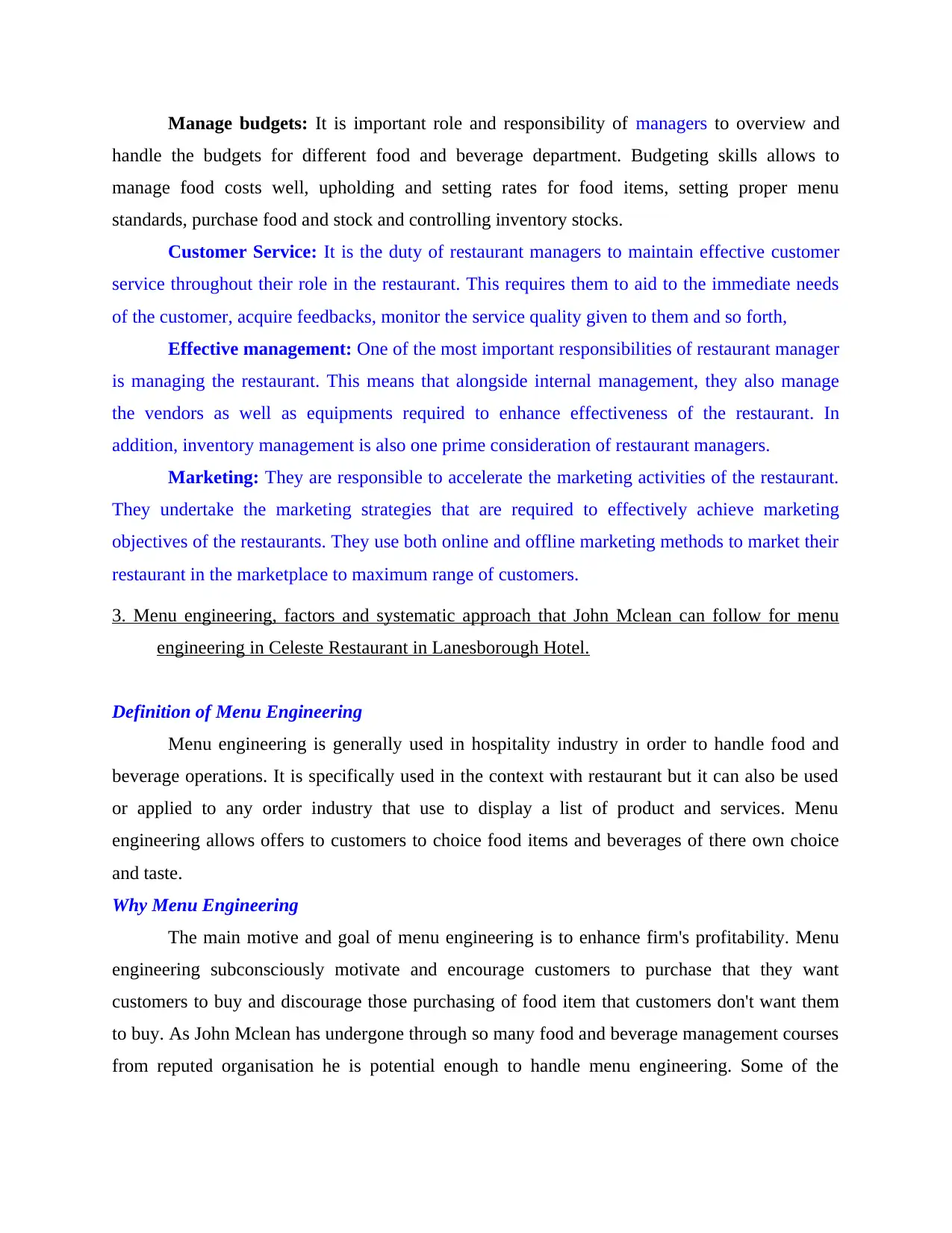
Manage budgets: It is important role and responsibility of managers to overview and
handle the budgets for different food and beverage department. Budgeting skills allows to
manage food costs well, upholding and setting rates for food items, setting proper menu
standards, purchase food and stock and controlling inventory stocks.
Customer Service: It is the duty of restaurant managers to maintain effective customer
service throughout their role in the restaurant. This requires them to aid to the immediate needs
of the customer, acquire feedbacks, monitor the service quality given to them and so forth,
Effective management: One of the most important responsibilities of restaurant manager
is managing the restaurant. This means that alongside internal management, they also manage
the vendors as well as equipments required to enhance effectiveness of the restaurant. In
addition, inventory management is also one prime consideration of restaurant managers.
Marketing: They are responsible to accelerate the marketing activities of the restaurant.
They undertake the marketing strategies that are required to effectively achieve marketing
objectives of the restaurants. They use both online and offline marketing methods to market their
restaurant in the marketplace to maximum range of customers.
3. Menu engineering, factors and systematic approach that John Mclean can follow for menu
engineering in Celeste Restaurant in Lanesborough Hotel.
Definition of Menu Engineering
Menu engineering is generally used in hospitality industry in order to handle food and
beverage operations. It is specifically used in the context with restaurant but it can also be used
or applied to any order industry that use to display a list of product and services. Menu
engineering allows offers to customers to choice food items and beverages of there own choice
and taste.
Why Menu Engineering
The main motive and goal of menu engineering is to enhance firm's profitability. Menu
engineering subconsciously motivate and encourage customers to purchase that they want
customers to buy and discourage those purchasing of food item that customers don't want them
to buy. As John Mclean has undergone through so many food and beverage management courses
from reputed organisation he is potential enough to handle menu engineering. Some of the
handle the budgets for different food and beverage department. Budgeting skills allows to
manage food costs well, upholding and setting rates for food items, setting proper menu
standards, purchase food and stock and controlling inventory stocks.
Customer Service: It is the duty of restaurant managers to maintain effective customer
service throughout their role in the restaurant. This requires them to aid to the immediate needs
of the customer, acquire feedbacks, monitor the service quality given to them and so forth,
Effective management: One of the most important responsibilities of restaurant manager
is managing the restaurant. This means that alongside internal management, they also manage
the vendors as well as equipments required to enhance effectiveness of the restaurant. In
addition, inventory management is also one prime consideration of restaurant managers.
Marketing: They are responsible to accelerate the marketing activities of the restaurant.
They undertake the marketing strategies that are required to effectively achieve marketing
objectives of the restaurants. They use both online and offline marketing methods to market their
restaurant in the marketplace to maximum range of customers.
3. Menu engineering, factors and systematic approach that John Mclean can follow for menu
engineering in Celeste Restaurant in Lanesborough Hotel.
Definition of Menu Engineering
Menu engineering is generally used in hospitality industry in order to handle food and
beverage operations. It is specifically used in the context with restaurant but it can also be used
or applied to any order industry that use to display a list of product and services. Menu
engineering allows offers to customers to choice food items and beverages of there own choice
and taste.
Why Menu Engineering
The main motive and goal of menu engineering is to enhance firm's profitability. Menu
engineering subconsciously motivate and encourage customers to purchase that they want
customers to buy and discourage those purchasing of food item that customers don't want them
to buy. As John Mclean has undergone through so many food and beverage management courses
from reputed organisation he is potential enough to handle menu engineering. Some of the
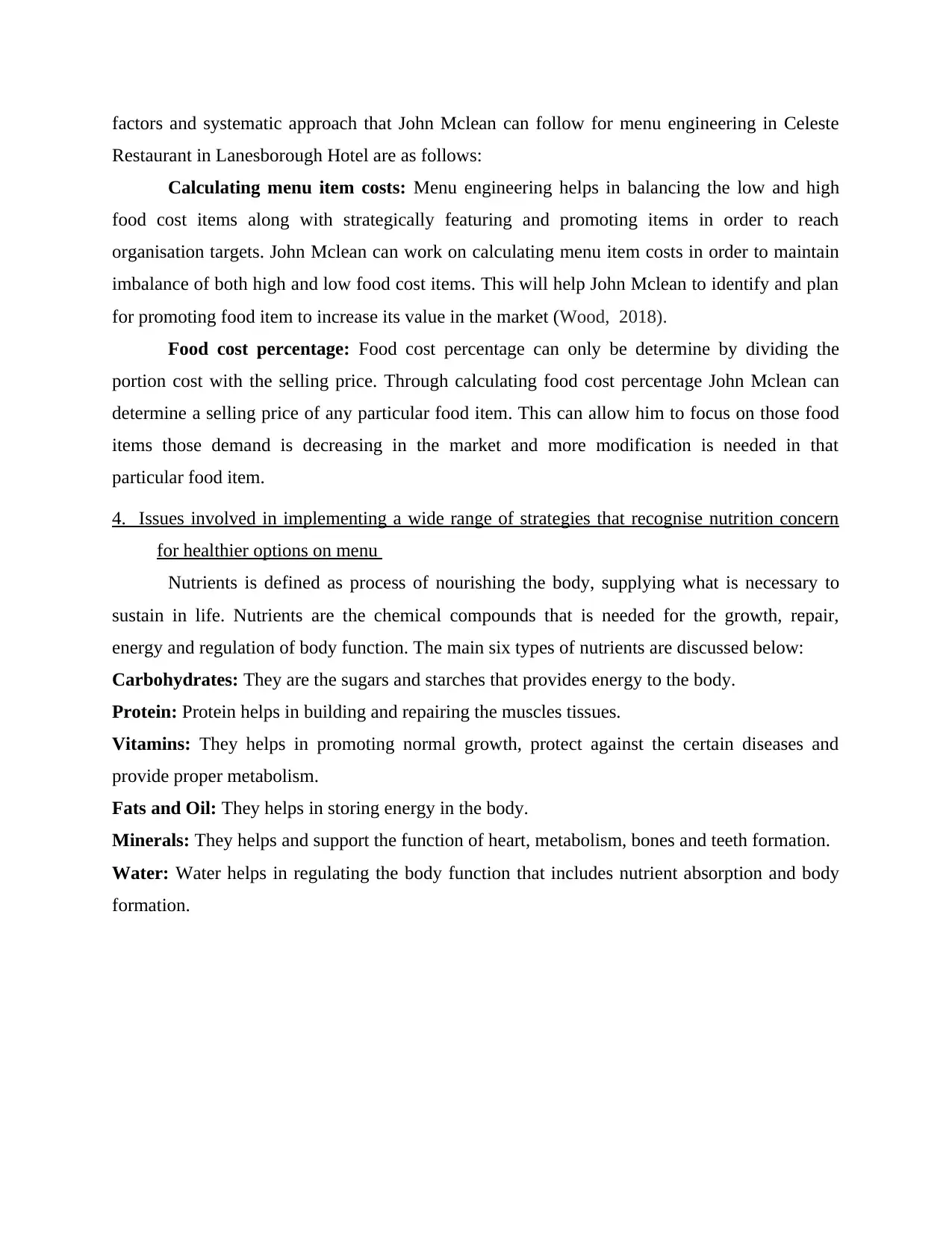
factors and systematic approach that John Mclean can follow for menu engineering in Celeste
Restaurant in Lanesborough Hotel are as follows:
Calculating menu item costs: Menu engineering helps in balancing the low and high
food cost items along with strategically featuring and promoting items in order to reach
organisation targets. John Mclean can work on calculating menu item costs in order to maintain
imbalance of both high and low food cost items. This will help John Mclean to identify and plan
for promoting food item to increase its value in the market (Wood, 2018).
Food cost percentage: Food cost percentage can only be determine by dividing the
portion cost with the selling price. Through calculating food cost percentage John Mclean can
determine a selling price of any particular food item. This can allow him to focus on those food
items those demand is decreasing in the market and more modification is needed in that
particular food item.
4. Issues involved in implementing a wide range of strategies that recognise nutrition concern
for healthier options on menu
Nutrients is defined as process of nourishing the body, supplying what is necessary to
sustain in life. Nutrients are the chemical compounds that is needed for the growth, repair,
energy and regulation of body function. The main six types of nutrients are discussed below:
Carbohydrates: They are the sugars and starches that provides energy to the body.
Protein: Protein helps in building and repairing the muscles tissues.
Vitamins: They helps in promoting normal growth, protect against the certain diseases and
provide proper metabolism.
Fats and Oil: They helps in storing energy in the body.
Minerals: They helps and support the function of heart, metabolism, bones and teeth formation.
Water: Water helps in regulating the body function that includes nutrient absorption and body
formation.
Restaurant in Lanesborough Hotel are as follows:
Calculating menu item costs: Menu engineering helps in balancing the low and high
food cost items along with strategically featuring and promoting items in order to reach
organisation targets. John Mclean can work on calculating menu item costs in order to maintain
imbalance of both high and low food cost items. This will help John Mclean to identify and plan
for promoting food item to increase its value in the market (Wood, 2018).
Food cost percentage: Food cost percentage can only be determine by dividing the
portion cost with the selling price. Through calculating food cost percentage John Mclean can
determine a selling price of any particular food item. This can allow him to focus on those food
items those demand is decreasing in the market and more modification is needed in that
particular food item.
4. Issues involved in implementing a wide range of strategies that recognise nutrition concern
for healthier options on menu
Nutrients is defined as process of nourishing the body, supplying what is necessary to
sustain in life. Nutrients are the chemical compounds that is needed for the growth, repair,
energy and regulation of body function. The main six types of nutrients are discussed below:
Carbohydrates: They are the sugars and starches that provides energy to the body.
Protein: Protein helps in building and repairing the muscles tissues.
Vitamins: They helps in promoting normal growth, protect against the certain diseases and
provide proper metabolism.
Fats and Oil: They helps in storing energy in the body.
Minerals: They helps and support the function of heart, metabolism, bones and teeth formation.
Water: Water helps in regulating the body function that includes nutrient absorption and body
formation.
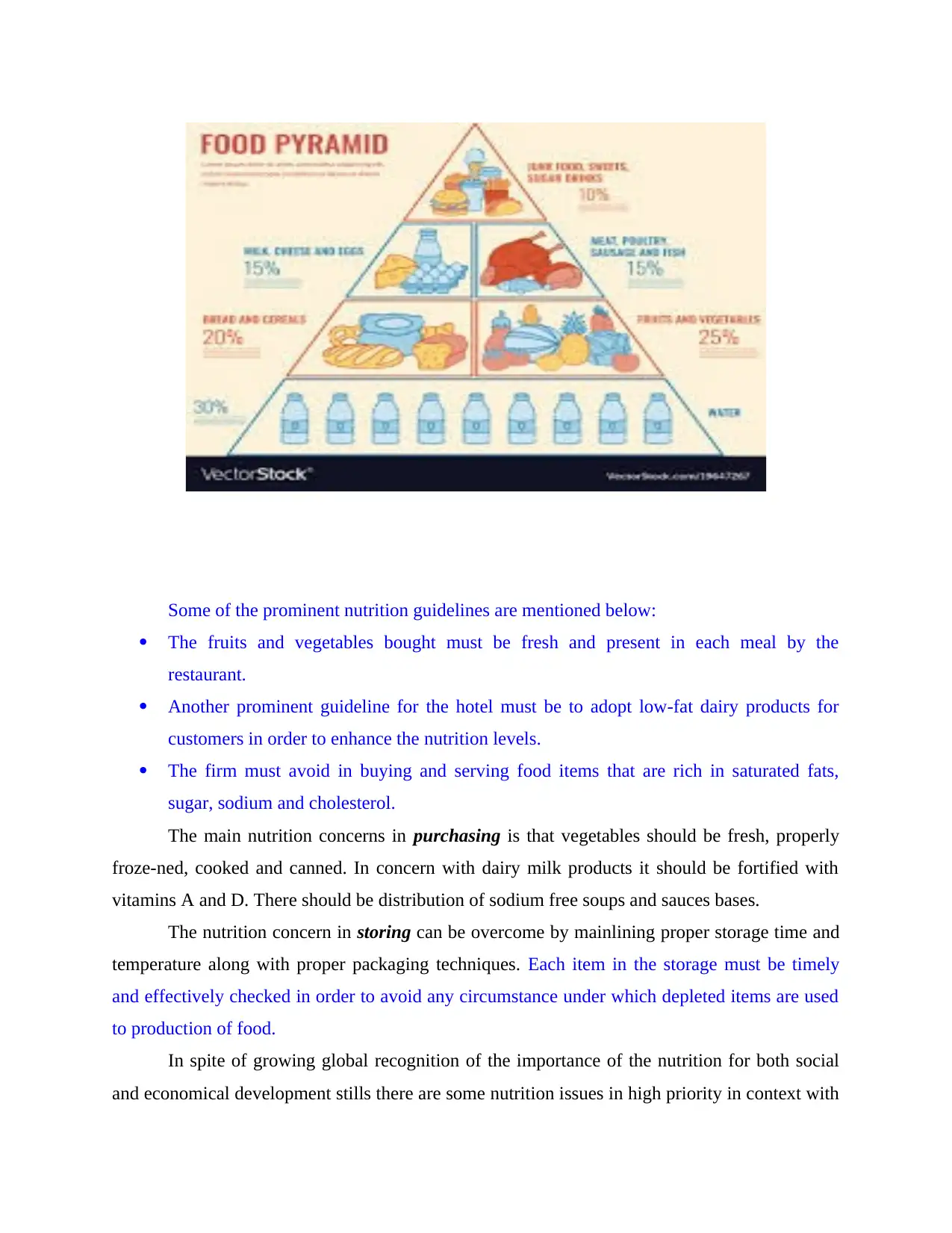
Some of the prominent nutrition guidelines are mentioned below:
The fruits and vegetables bought must be fresh and present in each meal by the
restaurant.
Another prominent guideline for the hotel must be to adopt low-fat dairy products for
customers in order to enhance the nutrition levels.
The firm must avoid in buying and serving food items that are rich in saturated fats,
sugar, sodium and cholesterol.
The main nutrition concerns in purchasing is that vegetables should be fresh, properly
froze-ned, cooked and canned. In concern with dairy milk products it should be fortified with
vitamins A and D. There should be distribution of sodium free soups and sauces bases.
The nutrition concern in storing can be overcome by mainlining proper storage time and
temperature along with proper packaging techniques. Each item in the storage must be timely
and effectively checked in order to avoid any circumstance under which depleted items are used
to production of food.
In spite of growing global recognition of the importance of the nutrition for both social
and economical development stills there are some nutrition issues in high priority in context with
The fruits and vegetables bought must be fresh and present in each meal by the
restaurant.
Another prominent guideline for the hotel must be to adopt low-fat dairy products for
customers in order to enhance the nutrition levels.
The firm must avoid in buying and serving food items that are rich in saturated fats,
sugar, sodium and cholesterol.
The main nutrition concerns in purchasing is that vegetables should be fresh, properly
froze-ned, cooked and canned. In concern with dairy milk products it should be fortified with
vitamins A and D. There should be distribution of sodium free soups and sauces bases.
The nutrition concern in storing can be overcome by mainlining proper storage time and
temperature along with proper packaging techniques. Each item in the storage must be timely
and effectively checked in order to avoid any circumstance under which depleted items are used
to production of food.
In spite of growing global recognition of the importance of the nutrition for both social
and economical development stills there are some nutrition issues in high priority in context with
Secure Best Marks with AI Grader
Need help grading? Try our AI Grader for instant feedback on your assignments.
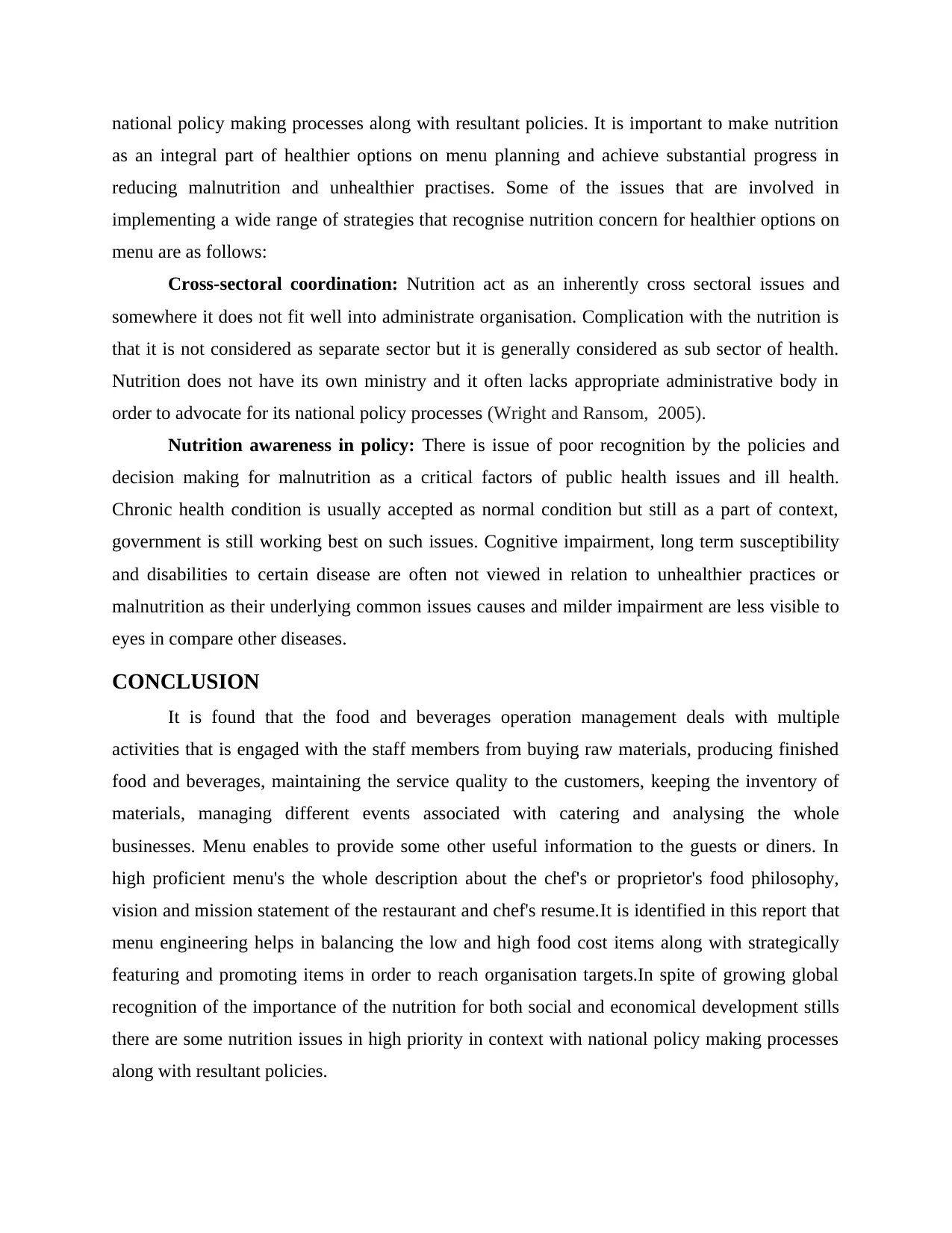
national policy making processes along with resultant policies. It is important to make nutrition
as an integral part of healthier options on menu planning and achieve substantial progress in
reducing malnutrition and unhealthier practises. Some of the issues that are involved in
implementing a wide range of strategies that recognise nutrition concern for healthier options on
menu are as follows:
Cross-sectoral coordination: Nutrition act as an inherently cross sectoral issues and
somewhere it does not fit well into administrate organisation. Complication with the nutrition is
that it is not considered as separate sector but it is generally considered as sub sector of health.
Nutrition does not have its own ministry and it often lacks appropriate administrative body in
order to advocate for its national policy processes (Wright and Ransom, 2005).
Nutrition awareness in policy: There is issue of poor recognition by the policies and
decision making for malnutrition as a critical factors of public health issues and ill health.
Chronic health condition is usually accepted as normal condition but still as a part of context,
government is still working best on such issues. Cognitive impairment, long term susceptibility
and disabilities to certain disease are often not viewed in relation to unhealthier practices or
malnutrition as their underlying common issues causes and milder impairment are less visible to
eyes in compare other diseases.
CONCLUSION
It is found that the food and beverages operation management deals with multiple
activities that is engaged with the staff members from buying raw materials, producing finished
food and beverages, maintaining the service quality to the customers, keeping the inventory of
materials, managing different events associated with catering and analysing the whole
businesses. Menu enables to provide some other useful information to the guests or diners. In
high proficient menu's the whole description about the chef's or proprietor's food philosophy,
vision and mission statement of the restaurant and chef's resume.It is identified in this report that
menu engineering helps in balancing the low and high food cost items along with strategically
featuring and promoting items in order to reach organisation targets.In spite of growing global
recognition of the importance of the nutrition for both social and economical development stills
there are some nutrition issues in high priority in context with national policy making processes
along with resultant policies.
as an integral part of healthier options on menu planning and achieve substantial progress in
reducing malnutrition and unhealthier practises. Some of the issues that are involved in
implementing a wide range of strategies that recognise nutrition concern for healthier options on
menu are as follows:
Cross-sectoral coordination: Nutrition act as an inherently cross sectoral issues and
somewhere it does not fit well into administrate organisation. Complication with the nutrition is
that it is not considered as separate sector but it is generally considered as sub sector of health.
Nutrition does not have its own ministry and it often lacks appropriate administrative body in
order to advocate for its national policy processes (Wright and Ransom, 2005).
Nutrition awareness in policy: There is issue of poor recognition by the policies and
decision making for malnutrition as a critical factors of public health issues and ill health.
Chronic health condition is usually accepted as normal condition but still as a part of context,
government is still working best on such issues. Cognitive impairment, long term susceptibility
and disabilities to certain disease are often not viewed in relation to unhealthier practices or
malnutrition as their underlying common issues causes and milder impairment are less visible to
eyes in compare other diseases.
CONCLUSION
It is found that the food and beverages operation management deals with multiple
activities that is engaged with the staff members from buying raw materials, producing finished
food and beverages, maintaining the service quality to the customers, keeping the inventory of
materials, managing different events associated with catering and analysing the whole
businesses. Menu enables to provide some other useful information to the guests or diners. In
high proficient menu's the whole description about the chef's or proprietor's food philosophy,
vision and mission statement of the restaurant and chef's resume.It is identified in this report that
menu engineering helps in balancing the low and high food cost items along with strategically
featuring and promoting items in order to reach organisation targets.In spite of growing global
recognition of the importance of the nutrition for both social and economical development stills
there are some nutrition issues in high priority in context with national policy making processes
along with resultant policies.
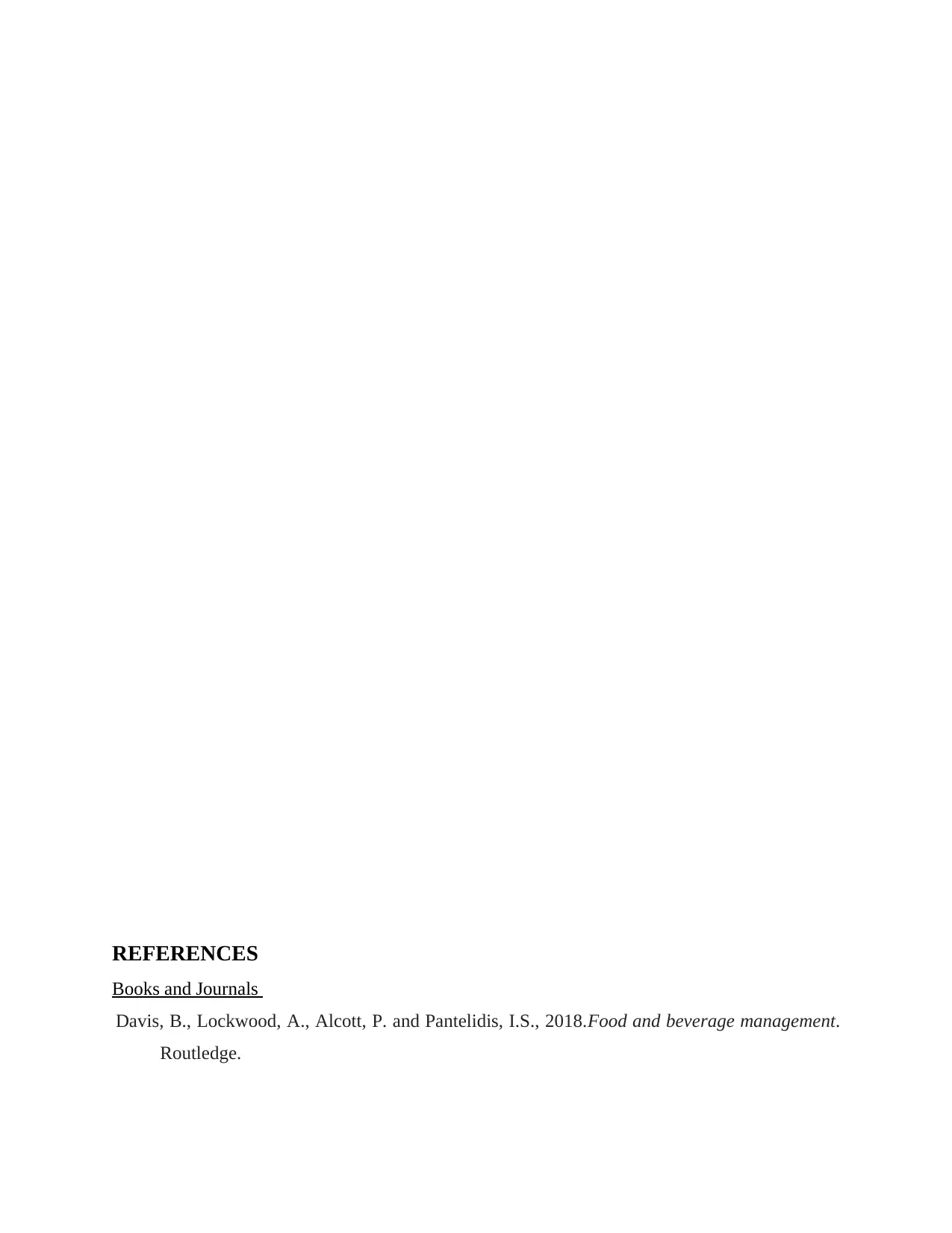
REFERENCES
Books and Journals
Davis, B., Lockwood, A., Alcott, P. and Pantelidis, I.S., 2018.Food and beverage management.
Routledge.
Books and Journals
Davis, B., Lockwood, A., Alcott, P. and Pantelidis, I.S., 2018.Food and beverage management.
Routledge.
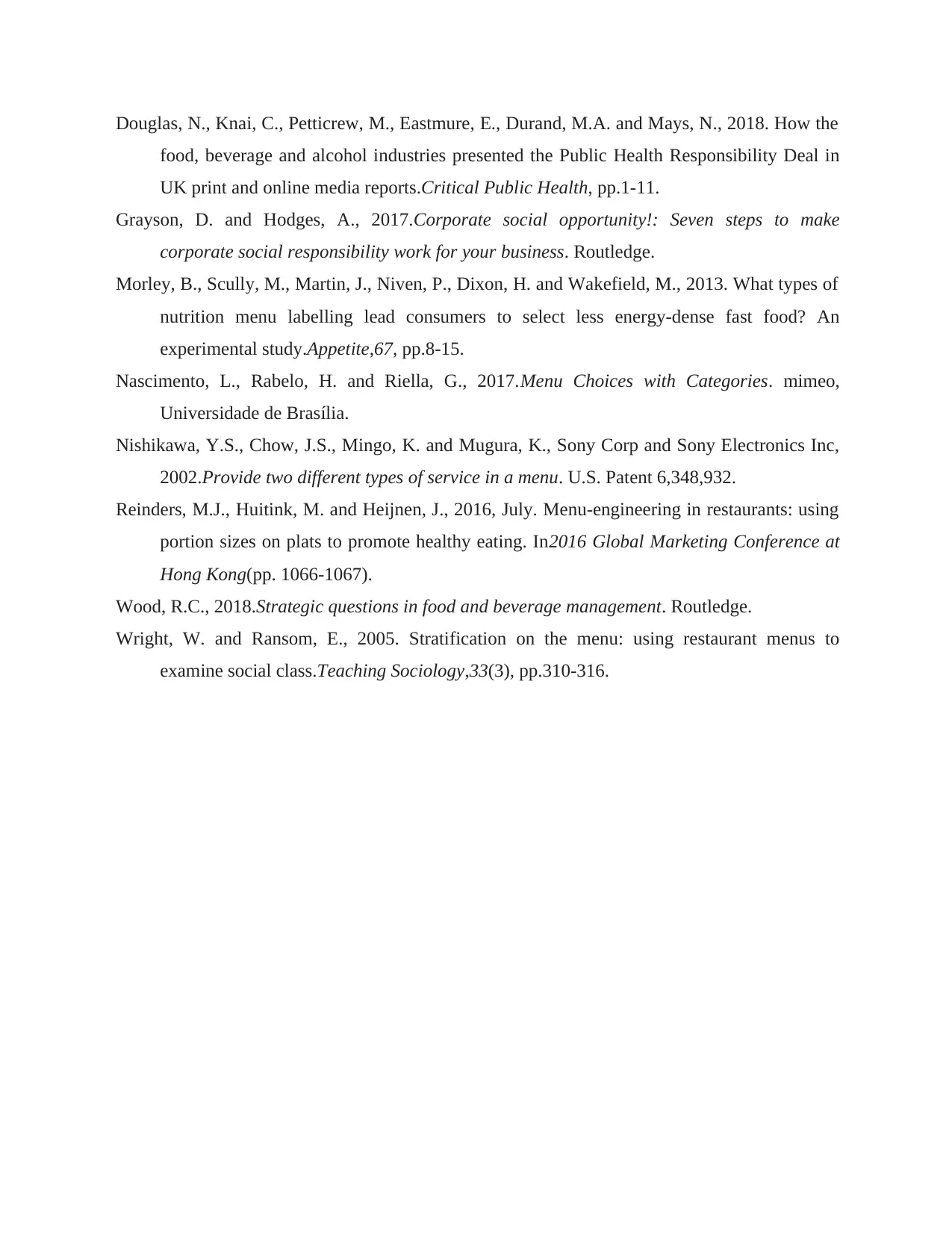
Douglas, N., Knai, C., Petticrew, M., Eastmure, E., Durand, M.A. and Mays, N., 2018. How the
food, beverage and alcohol industries presented the Public Health Responsibility Deal in
UK print and online media reports.Critical Public Health, pp.1-11.
Grayson, D. and Hodges, A., 2017.Corporate social opportunity!: Seven steps to make
corporate social responsibility work for your business. Routledge.
Morley, B., Scully, M., Martin, J., Niven, P., Dixon, H. and Wakefield, M., 2013. What types of
nutrition menu labelling lead consumers to select less energy-dense fast food? An
experimental study.Appetite,67, pp.8-15.
Nascimento, L., Rabelo, H. and Riella, G., 2017.Menu Choices with Categories. mimeo,
Universidade de Brasília.
Nishikawa, Y.S., Chow, J.S., Mingo, K. and Mugura, K., Sony Corp and Sony Electronics Inc,
2002.Provide two different types of service in a menu. U.S. Patent 6,348,932.
Reinders, M.J., Huitink, M. and Heijnen, J., 2016, July. Menu-engineering in restaurants: using
portion sizes on plats to promote healthy eating. In2016 Global Marketing Conference at
Hong Kong(pp. 1066-1067).
Wood, R.C., 2018.Strategic questions in food and beverage management. Routledge.
Wright, W. and Ransom, E., 2005. Stratification on the menu: using restaurant menus to
examine social class.Teaching Sociology,33(3), pp.310-316.
food, beverage and alcohol industries presented the Public Health Responsibility Deal in
UK print and online media reports.Critical Public Health, pp.1-11.
Grayson, D. and Hodges, A., 2017.Corporate social opportunity!: Seven steps to make
corporate social responsibility work for your business. Routledge.
Morley, B., Scully, M., Martin, J., Niven, P., Dixon, H. and Wakefield, M., 2013. What types of
nutrition menu labelling lead consumers to select less energy-dense fast food? An
experimental study.Appetite,67, pp.8-15.
Nascimento, L., Rabelo, H. and Riella, G., 2017.Menu Choices with Categories. mimeo,
Universidade de Brasília.
Nishikawa, Y.S., Chow, J.S., Mingo, K. and Mugura, K., Sony Corp and Sony Electronics Inc,
2002.Provide two different types of service in a menu. U.S. Patent 6,348,932.
Reinders, M.J., Huitink, M. and Heijnen, J., 2016, July. Menu-engineering in restaurants: using
portion sizes on plats to promote healthy eating. In2016 Global Marketing Conference at
Hong Kong(pp. 1066-1067).
Wood, R.C., 2018.Strategic questions in food and beverage management. Routledge.
Wright, W. and Ransom, E., 2005. Stratification on the menu: using restaurant menus to
examine social class.Teaching Sociology,33(3), pp.310-316.
1 out of 13
Related Documents
Your All-in-One AI-Powered Toolkit for Academic Success.
+13062052269
info@desklib.com
Available 24*7 on WhatsApp / Email
![[object Object]](/_next/static/media/star-bottom.7253800d.svg)
Unlock your academic potential
© 2024 | Zucol Services PVT LTD | All rights reserved.





